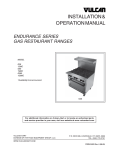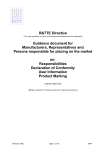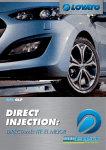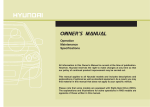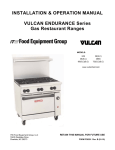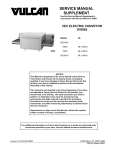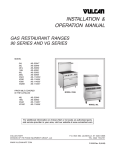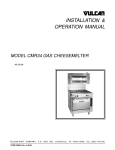Download Vulcan-Hart G60F Service manual
Transcript
SERVICE MANUAL ENDURANCE SERIES GAS RANGES MODELS G36 G36C G60 G60C G260 G260C G481 G481C - NOTICE This manual is prepared for the use of trained Vulcan Service Technicians and should not be used by those not properly qualified. If you have attended a Vulcan Service School for this product, you may be qualified to perform all the procedures described in this manual. This manual is not intended to be all encompassing. If you have not attended a Vulcan Service School for this product, you should read, in its entirety, the repair procedure you wish to perform to determine if you have the necessary tools, instruments and skills required to perform the procedure. Procedures for which you do not have the necessary tools, instruments and skills should be performed by a trained Vulcan Service Technician. Reproduction or other use of this Manual, without the express written consent of Vulcan, is prohibited. For additional information on Vulcan-Hart or to locate an authorized parts and service provider in your area, visit our website at www.vulcanhart.com VULCAN-HART DIVISION OF ITW FOOD EQUIPMENT GROUP, LLC WWW.VULCANHART.COM 3600 NORTH POINT BLVD. BALTIMORE, MD 21222 F35648 (May 2005) ENDURANCE SERIES GAS RANGES TABLE OF CONTENTS GENERAL ............................................................................................................................................................... 3 Introduction ...................................................................................................................................................... 3 Installation ........................................................................................................................................................ 3 Operation ......................................................................................................................................................... 3 Cleaning .......................................................................................................................................................... 3 Lubrication ....................................................................................................................................................... 3 Specifications ................................................................................................................................................... 3 Tools ................................................................................................................................................................ 3 REMOVAL AND REPLACEMENT OF PARTS ......................................................................................................... 4 Covers and Panels ........................................................................................................................................... 4 Oven Manifold Cover (Models 60, 260, and 481) ...................................................................................... 4 Oven Control Panel (Model 36) ............................................................................................................... 4 Broiler Manifold Cover .............................................................................................................................. 5 Kick Panel Assembly ................................................................................................................................ 5 Standard Oven Control Valve/Thermocouple ................................................................................................... 6 Model 36 Only .......................................................................................................................................... 6 Model 60, 260, and 481 ............................................................................................................................ 7 Oven Pilot Assembly ........................................................................................................................................ 8 Oven Burner Assembly .................................................................................................................................... 8 Convection Oven Control Valve/Thermocouple Pilot ........................................................................................ 9 Oven Burner Nozzle and Orifice ..................................................................................................................... 10 Pilot Valve and Quick Disconnect Valve ......................................................................................................... 10 Top Section Burner Valve ............................................................................................................................... 11 Switch Replacement ...................................................................................................................................... 11 Motor Replacement ........................................................................................................................................ 11 Convection Oven Solenoid ............................................................................................................................. 12 SERVICE PROCEDURES AND ADJUSTMENTS ................................................................................................. 13 Pilot Flame Height .......................................................................................................................................... 13 Top Burners ............................................................................................................................................ 13 Broiler/Griddle......................................................................................................................................... 13 Air Shutter Adjustment ................................................................................................................................... 13 Oven Burner Adjustment ................................................................................................................................ 13 Regulator Check ............................................................................................................................................ 14 Regulator Adjustment ..................................................................................................................................... 14 Oven Burner Nozzle and Orifice Check .......................................................................................................... 15 Convection Oven Motor and Door Switch Check ........................................................................................... 15 Convection Oven Solenoid Check .................................................................................................................. 16 ELECTRICAL OPERATION ................................................................................................................................... 18 Component Function ...................................................................................................................................... 18 Sequence of Operation .................................................................................................................................. 18 Schematic Diagram........................................................................................................................................ 19 Wiring Diagrams ............................................................................................................................................ 20 Double Oven 120 Volt Endurance Convection Range (Drawing 1 of 2) .................................................. 20 Double Oven 120 Volt Endurance Convection Range (Drawing 2 of 2) .................................................. 21 TROUBLESHOOTING .......................................................................................................................................... 22 CONDENSED SPARE PARTS LIST ...................................................................................................................... 23 ©VULCAN 2005 F35425 (October 2005) Page 2 of 23 ENDURANCE SERIES GAS RANGES - GENERAL GENERAL INTRODUCTION TOOLS Procedures in this manual will apply to all models unless specified. Pictures and illustrations can be of any model unless the picture or illustration needs to be model specific. Standard • Standard set of hand tools. • VOM with A.C. current tester (Any quality VOM with a sensitivity of at lease 20,000 ohms per volt can be used). • Gear puller to remove blower. INSTALLATION Refer to the Installation and Operation Manual for detailed installation instructions on ranges. Special OPERATION • Temperature tester (thermocouple type). • Manometer. Refer to the Installation and Operation Manual for specific operating instructions. SPECIFICATIONS Electrical (Convection ranges only) CLEANING Refer to the Installation and Operation Manual for specific cleaning instructions. LUBRICATION • Voltage - 120/60/1 or 240/60/1 (optional) • Amps - 15 Amps • Frequency - 50/60 Hz Gas Line Pressures The blower motor has sealed bearings and requires no additional lubrication. • Natural - Recommended (in. W.C.) 7.0, min 5.0 • Propane - Recommended (in. W.C.) 11.0, min 11.0 Maximum 14.0 in. W.C. (Nat. or Prop.) Orifice Size Requirements for Different Elevations for Restaurant Range OPEN TOP GRIDDLE BRO/GRID (STD) OVEN (CON) OVEN 32000/35000 15,000 10,000 35,000 35,000 ORIFICE SIZE NAT/PROP NAT/PROP NAT/PROP NAT/PROP NAT/PROP SEA LEVEL TO 2499 FT 36/51 (32000) 50/57 53/63 33/51 33/51 2499 FT TO 4499 FT 40/53 (32000) 37/52 (35000) 51/57 54/65 37/52 37/52 4500 FT TO 6499 FT 41/53 (32000) 38/52 (35000) 51/58 54/65 38/52 38/52 6500 FT TO 8499 FT 42/53 (32000) 40/53 (35000) 52/59 55/66 40/53 40/53 8500 FT TO 10,500 FT 42/54 (32000) 41/53 (35000) 52/60 55/67 41/53 41/53 INPUT AT SEA LEVEL PER BURNER (BTU’S) 33/1.75MM (35000) Page 3 of 23 F35425 (October 2005) ENDURANCE SERIES GAS RANGES - REMOVAL AND REPLACEMENT OF PARTS REMOVAL AND REPLACEMENT OF PARTS COVERS AND PANELS 3. Remove screws holding manifold cover in place and remove manifold cover. 4. Reverse the procedure to install the oven manifold cover. WARNING: DISCONNECT THE ELECTRICAL POWER TO THE MACHINE AND FOLLOW LOCKOUT / TAGOUT PROCEDURES. Oven Manifold Cover (Models 60, 260, and 481) 1. 2. Rotate the yellow gas shut-off valve to the OFF position and allow range to cool. Loosen the setscrew in the side of the burner control knobs and oven control knob and remove knobs. F35425 (October 2005) Oven Control Panel (Model 36) 1. Rotate the yellow gas shut-off valve to the OFF position and allow range to cool. 2. Remove the red oven control valve knob from the control valve. 3. Open the kick plate at the bottom of the range. Page 4 of 23 ENDURANCE SERIES GAS RANGES - REMOVAL AND REPLACEMENT OF PARTS 4. Remove the screw securing the oven control panel and remove the panel. 3. Remove screws holding manifold cover in place and remove broiler manifold cover. 4. Reverse the procedure to install the broiler manifold cover. Kick Panel Assembly 5. 1. Open kick panel. 2. Remove two screws securing left hinge and remove hinge. 3. Slide kick plate to the left to disengage from left hinge. 4. Reverse the procedure to install the kick plate assembly. Reverse the procedure to install the oven control panel. Broiler Manifold Cover 1. Rotate the yellow gas shut-off valve to the OFF position and allow range to cool. 2. Loosen the setscrew in the side of the burner control knobs and remove knobs. Page 5 of 23 F35425 (October 2005) ENDURANCE SERIES GAS RANGES - REMOVAL AND REPLACEMENT OF PARTS 3. Remove the two screws attaching the bracket to the thermocouple. Model 36 4. Open the oven door. The oven control valve is located to the front left of the oven. 5. Remove capillary tube from all routing clips. STANDARD OVEN CONTROL VALVE/THERMOCOUPLE WARNING: DISCONNECT THE ELECTRICAL POWER TO THE MACHINE AND FOLLOW LOCKOUT / TAGOUT PROCEDURES. WARNING: SHUT OFF THE GAS BEFORE SERVICING THE UNIT. WARNING: ALL GAS JOINTS DISTURBED DURING SERVICING MUST BE CHECKED FOR LEAKS. CHECK WITH A SOAP AND WATER SOLUTION (BUBBLES). DO NOT USE AN OPEN FLAME. 1. Remove the oven control panel as outlined under PANELS AND COVERS. 2. Remove the three bracket screws attaching the thermocouple valve mounting bracket to the range. NOTE: When straightening the capillary tube be sure not to place kinks in tubing. F35425 (October 2005) Page 6 of 23 6. ENDURANCE SERIES GAS RANGES - REMOVAL AND REPLACEMENT OF PARTS Slide the capillary tube out of the bracket and Model 60, 260, and 481 straighten the tube so that it can be passed The control valves are located behind the oven through the hole in the oven sidewall. manifold cover. 7. Carefully slide the capillary tube through the hole in the oven sidewall. 8. Disconnect the gas input to the control valve. 9. Disconnect the pilot tubing. 1. Remove the oven manifold cover as outlined under COVERS AND PANELS. 2. Remove top burner grates and deflector, if necessary, to access the control valve. 3. Disconnect the pilot tubing from the control valve. 4. Remove two screws securing the control valve to the manifold. 10. Disconnect the control valve burner tubing. 11. Remove the control valve assembly from the oven. 12. Reverse the procedure to install a new control valve assembly. NOTE: During installation do not kink the new capillary tube when feeding it through the hole in the side of the oven cavity. Excess tubing can be loosely wrapped. Page 7 of 23 F35425 (October 2005) ENDURANCE SERIES GAS RANGES - REMOVAL AND REPLACEMENT OF PARTS 5. Remove the kick plate as outlined under COVERS AND PANELS. The oven pilot assembly is attached to the burner assembly behind the kick plate. NOTE: Do not kink the capillary tube when straightening the tubing for removal. 1. Remove the kick plate as outlined under COVERS AND PANELS. 6. 2. Remove the oven rack. 3. Remove the oven bottom. 4. Remove the oven left and right liner. 5. Remove the oven bottom heat shield. 6. Remove the screws securing oven pilot assembly to the burner assembly. 7. Pull the pilot assembly out through the front of oven. 8. Reverse the procedure to install the oven pilot assembly. 7. Slide the capillary tube and thermocouple out of the bracket and straighten the tube so that it can be passed through the holes in the oven liner. Remove the capillary tube from all routing clips. 8. Carefully slide the capillary tube and thermocouple through the holes in the oven. 9. Remove the control valve, capillary tube, and thermocouple from the unit. 10. Reverse the procedure to install a new control valve assembly. OVEN BURNER ASSEMBLY NOTE: During installation do not kink the new capillary tube when feeding it through the holes in the oven. Excess tubing can be loosely wrapped. WARNING: DISCONNECT THE ELECTRICAL POWER TO THE MACHINE AND FOLLOW LOCKOUT / TAGOUT PROCEDURES. OVEN PILOT ASSEMBLY WARNING: DISCONNECT THE ELECTRICAL POWER TO THE MACHINE AND FOLLOW LOCKOUT / TAGOUT PROCEDURES. WARNING: SHUT OFF THE GAS BEFORE SERVICING THE UNIT. WARNING: ALL GAS JOINTS DISTURBED DURING SERVICING MUST BE CHECKED FOR LEAKS. CHECK WITH A SOAP AND WATER SOLUTION (BUBBLES). DO NOT USE AN OPEN FLAME. F35425 (October 2005) WARNING: SHUT OFF THE GAS BEFORE SERVICING THE UNIT. WARNING: ALL GAS JOINTS DISTURBED DURING SERVICING MUST BE CHECKED FOR LEAKS. CHECK WITH A SOAP AND WATER SOLUTION (BUBBLES). DO NOT USE AN OPEN FLAME. The oven burner assembly is located behind the kick plate. 1. Page 8 of 23 Remove the oven pilot assembly as outlined under OVEN PILOT ASSEMBLY. ENDURANCE SERIES GAS RANGES - REMOVAL AND REPLACEMENT OF PARTS 2. Remove the two screws securing the oven burner assembly. 3. Disconnect gas line to the burner. 4. Pull the oven burner assembly out of the oven. 5. Reverse the procedure to install a new oven burner assembly. 5. CONVECTION OVEN CONTROL VALVE/THERMOCOUPLE PILOT Remove the kick plate as outlined under COVERS AND PANELS. NOTE: Do not kink the capillary tube when straightening the tubing for removal. 6. Slide the capillary tube and thermocouple out of the bracket and straighten the tube so that it can be passed through the holes in the oven liner. 7. Remove the capillary tube from all routing clips. WARNING: DISCONNECT THE ELECTRICAL POWER TO THE MACHINE AND FOLLOW LOCKOUT / TAGOUT PROCEDURES. WARNING: SHUT OFF THE GAS BEFORE SERVICING THE UNIT. WARNING: ALL GAS JOINTS DISTURBED DURING SERVICING MUST BE CHECKED FOR LEAKS. CHECK WITH A SOAP AND WATER SOLUTION (BUBBLES). DO NOT USE AN OPEN FLAME. The control valve is located behind the oven manifold cover. 1. Remove the oven manifold cover as outlined under COVERS AND PANELS. 8. Carefully slide the capillary tube and thermocouple through the holes in the oven. 2. Remove top burner grates and deflector, if necessary, to access the control valve. 9. Remove the control valve, capillary tube and thermocouple from the unit. 3. Disconnect the pilot tubing. 4. Remove the two screws securing the control valve to the manifold. 10. Reverse the procedure to install a new control valve assembly. NOTE: During installation do not kink the new capillary tube when feeding it through the holes in the oven. Excess tubing can be loosely wrapped. Page 9 of 23 F35425 (October 2005) ENDURANCE SERIES GAS RANGES - REMOVAL AND REPLACEMENT OF PARTS OVEN BURNER NOZZLE AND ORIFICE PILOT VALVE AND QUICK DISCONNECT VALVE WARNING: DISCONNECT THE ELECTRICAL POWER TO THE MACHINE AND FOLLOW LOCKOUT / TAGOUT PROCEDURES. WARNING: DISCONNECT THE ELECTRICAL POWER TO THE MACHINE AND FOLLOW LOCKOUT / TAGOUT PROCEDURES. WARNING: SHUT OFF THE GAS BEFORE SERVICING THE UNIT. WARNING: SHUT OFF THE GAS BEFORE SERVICING THE UNIT. WARNING: ALL GAS JOINTS DISTURBED DURING SERVICING MUST BE CHECKED FOR LEAKS. CHECK WITH A SOAP AND WATER SOLUTION (BUBBLES). DO NOT USE AN OPEN FLAME. WARNING: ALL GAS JOINTS DISTURBED DURING SERVICING MUST BE CHECKED FOR LEAKS. CHECK WITH A SOAP AND WATER SOLUTION (BUBBLES). DO NOT USE AN OPEN FLAME. The oven burner nozzle is mounted between the oven gas supply tubing and the u-burner assembly. The pilot valve for the griddle burners is mounted on the gas supply manifold located behind the griddle control panel. 1. Turn off the burners. 2. Disconnect the unit from gas flow and allow to cool completely. 3. Remove the kick plate as outlined under COVERS AND PANELS. 4. Remove the burner nozzle. 5. Check for blockage or damage. 6. Reverse the procedure to install the burner nozzle. F35425 (October 2005) 1. Remove the oven manifold cover as outlined under COVERS AND PANELS. 2. Remove top burner grates and deflector, if necessary, to access the pilot valve. 3. Disconnect the pilot tubing from the holder. 4. Disconnect the holder from the pilot valve. 5. Remove the pilot valve from the manifold. 6. Reverse the procedure to install a new pilot valve. Page 10 of 23 ENDURANCE SERIES GAS RANGES - REMOVAL AND REPLACEMENT OF PARTS TOP SECTION BURNER CONTROL VALVE 3. Disconnect wiring from the switch. 4. Remove the switch from mounting. 5. Reverse the procedure to install the replacement switch. WARNING: DISCONNECT THE ELECTRICAL POWER TO THE MACHINE AND FOLLOW LOCKOUT / TAGOUT PROCEDURES. WARNING: SHUT OFF THE GAS BEFORE SERVICING THE UNIT. WARNING: ALL GAS JOINTS DISTURBED DURING SERVICING MUST BE CHECKED FOR LEAKS. CHECK WITH A SOAP AND WATER SOLUTION (BUBBLES). DO NOT USE AN OPEN FLAME. MOTOR REPLACEMENT 1. Remove the oven manifold cover as outlined under COVERS AND PANELS. 2. Allow the range to cool completely. 3. Remove the burner grates and deflectors, if necessary. 4. Remove the griddle plate assembly, if necessary. 5. Remove the burner mounting screws. 6. Carefully move the burner assembly away from the burner control valve. NOTE: A centrifugal switch is mounted inside the motor assembly. If electrical voltage is available to the motor, the motor and switch must be replaced. 7. Remove the burner control valve from the manifold. 1. Remove cover from the motor junction box. 8. Clean the manifold of any thread sealant. 9. Inspect the control valve for wear and damage, replace as necessary. 2. Disconnect motor wiring at the junction box. 3. If necessary, remove the motor guard. WARNING: DISCONNECT THE ELECTRICAL POWER TO THE MACHINE AND FOLLOW LOCKOUT / TAGOUT PROCEDURES. 10. Reverse the procedure to install a new burner control valve. NOTE: Apply a light coat of thread sealant to the control valve threads before installing the burner control valve in the manifold. SWITCH REPLACEMENT WARNING: DISCONNECT THE ELECTRICAL POWER TO THE MACHINE AND FOLLOW LOCKOUT / TAGOUT PROCEDURES. 1. Remove the oven manifold cover as outlined under COVERS AND PANELS. 2. Allow the range to cool completely. Page 11 of 23 F35425 (October 2005) ENDURANCE SERIES GAS RANGES - REMOVAL AND REPLACEMENT OF PARTS 4. Inside the oven remove the hex head bolts and spacers attaching the motor grate to the motor mounting plate and remove the motor grate. CONVECTION OVEN SOLENOID WARNING: DISCONNECT THE ELECTRICAL POWER TO THE MACHINE AND FOLLOW LOCKOUT / TAGOUT PROCEDURES. WARNING: SHUT OFF THE GAS BEFORE SERVICING THE UNIT. WARNING: ALL GAS JOINTS DISTURBED DURING SERVICING MUST BE CHECKED FOR LEAKS. CHECK WITH A SOAP AND WATER SOLUTION (BUBBLES). DO NOT USE AN OPEN FLAME. 5. Remove the motor and rotor blower assembly from inside the oven. 6. Remove the fan from the motor. 7. Remove motor from motor mounting plate. 8. Reverse the procedure to install a new motor. F35425 (October 2005) 1. Disconnect gas supply to the range. 2. Disconnect the solenoid electrical connectors. 3. Disconnect gas supply lines from both sides of the solenoid. 4. Remove solenoid mounting screws and solenoid. 5. Reverse the procedure to install the replacement solenoid. Page 12 of 23 ENDURANCE SERIES GAS RANGES - REMOVAL AND REPLACEMENT OF PARTS SERVICE PROCEDURES AND ADJUSTMENTS WARNING: CERTAIN PROCEDURES IN THIS SECTION REQUIRE ELECTRICAL TEST OR MEASUREMENTS WHILE POWER IS APPLIED TO THE MACHINE. EXERCISE EXTREME CAUTION AT ALL TIMES. IF TEST POINTS ARE NOT EASILY ACCESSIBLE, DISCONNECT POWER AND FOLLOW LOCKOUT / TAGOUT PROCEDURES, ATTACH TEST EQUIPMENT AND REAPPLY POWER TO TEST. PILOT FLAME HEIGHT Top Burners To adjust the pilot flame height of the top burners, locate the pilot adjustment screws found on the front manifold pipe. It is not necessary to remove the manifold cover as adjustment access holes have been provided in the panel. streaming flame on the burner is an indication of insufficient air. To correct this condition, rotate the air shutter open until the burner flame begins to lift from the burner, then close the shutter slightly. OVEN BURNER ADJUSTMENT 1. Locate the pilot adjustment screw located behind the adjustment access hole in the panel. 2. Rotate the screw clockwise to decrease and counterclockwise to increase the flame height. All Endurance Range series units equipped with a pressure regulator and fixed orifices have been adjusted at the factory and should require no further adjustments. However, the efficiency of the range depends on a delicate balance between the air supply and the volume of gas. Whenever this balance is disturbed, poor operating characteristics and excessive gas consumption will occur. An air shutter on the front of the oven burner controls the gas mixer balance. Broiler/Griddle To adjust pilot flame height of broiler/griddle, locate the pilot adjustment screws found on the broiler/ griddle manifold pipe. It is not necessary to remove the manifold cover, as adjustment access holes have been provided in the panel. 1. Locate the pilot adjustment screw located behind the adjustment access hole in the panel. 2. Rotate the screw clockwise to decrease and counterclockwise to increase the flame height. AIR SHUTTER ADJUSTMENT The efficiency of the oven depends on a delicate balance between the air supply and the volume of gas. Whenever this balance is disturbed, poor operating characteristics and excessive gas consumption will occur. An air shutter on the front of the oven burner controls the gas mixer balance. A yellow Page 13 of 23 F35425 (October 2005) ENDURANCE SERIES GAS RANGES - SERVICE PROCEDURES AND ADJUSTMENTS A yellow streaming flame on the burner is an indication of insufficient air. To correct this condition, open the air shutter until the burner flame begins to lift from the burner, then close the shutter slightly and lock into place. REGULATOR CHECK A gas regulator is mounted between the gas service outlet and the appliance. 5. With regulator reading 7.0" W.C. (natural gas) or 11.0" W.C. (propane gas), turn on two top burners. 6. Check regulator pressure reading. The reading should be steady ± 0.10". If fluctuation in excess of ±0.10" occurs replace the regulator. NOTE: If pressure readings climb to limits shown in step 4 with the burners OFF, check the leak (vent) limit device for obstruction. Check the regulator for leaks at the leak limiter vent. If vent is leaking, replace the regulator. REGULATOR ADJUSTMENT NOTE: Before adjusting regulator, check incoming gas line pressure. Incoming pressure must be 7.0" W.C. for natural gas and 11.0" W.C. for propane gas. If incoming pressure is not correct have the gas source checked and adjusted as necessary. Make sure the regulator is mounted in the horizontal position with the arrow pointing in the direction of gas flow. When servicing the equipment for possible gas pressure problems, visually check that a regulator is installed horizontal with the gas flow arrow pointing in the direction of gas flow. 1. Turn on the range top burners. 2. Observe the burner flames. 1. Connect manometer to the pressure tap provided on the range gas piping between the regulator and range. 2. Check manometer reading. The reading should be 7.0" W.C. for natural gas and 11.0" W.C. for propane gas. 3. If incoming line pressure is correct, adjust the regulator. Remove the regulator closing nut. 4. Insert a flat edge screwdriver through the top of the regulator. Turn the adjusting screw clockwise to increase pressure and counterclockwise to decrease pressure. 5. While watching the manometer, turn the adjusting screw for proper regulator outlet pressure. 6. Install the regulator closing nut. A leak (vent) limiting device is installed in each regulator to limit gas leakage if the regulator ruptures. Do not obstruct the leak limiter (vent). Obstruction may cause regulator malfunction or failure. 3. Connect the manometer to the pressure tap provided between the regulator and range supply piping. 4. Turn on two top burners and note manometer reading. The reading should be 7.0" W.C. for natural gas units and 11.0" W.C. for propane gas units. If readings are lower, check incoming gas line pressure. NOTE: The line pressure should never drop below 5.0" W.C. for natural gas or 11.0" W.C. for propane gas. The incoming line pressure must be correct for proper range operation. If line pressure is incorrect have the gas supply source checked and adjusted. If line pressure is correct adjust the regulator as follows. F35425 (October 2005) Page 14 of 23 ENDURANCE SERIES GAS RANGES - SERVICE PROCEDURES AND ADJUSTMENTS OVEN BURNER NOZZLE AND ORIFICE CHECK The oven burner nozzle is mounted between the oven gas supply tubing and the u-burner assembly. If burner operation seems poor and other systems have been checked, remove the burner nozzle and check for blockage or damage. 1. Shut off the yellow gas supply knob. 2. Allow the range to cool completely. 3. Disconnect electrical power to the range. 4. Loosen the screws in the sides of the control valve knobs and remove the knobs. 5. Remove the control panel mounting screws and the control panel cover. 6. Activate the power switch (see illustration) several times and check for wear, damage, and loose wiring connections. Repair connections as necessary. 1. Turn off burners and oven. 2. Disconnect unit from gas flow and allow to cool completely. 3. Remove the kick plate as outlined under COVERS AND PANELS. 7. Connect electrical power to the range. 4. Remove the burner nozzle. 8. 5. Check for blockage or damage. Check power connections for power range (220 volts AC or 120 volts AC). 9. With the power switch in the ON position, check for voltage at both switch connections. If no voltage is available, check power source and breakers. If voltage is available at switch input only, replace the switch. 10. If voltage is available at power switch connections, remove kick plate as outlined under COVERS AND PANELS. 11. Locate the door switch. 12. Disconnect electrical power to the range. NOTE: Nozzle blockage can be cleaned or nozzle replaced. Use high-pressure water and tip cleaner to clean the nozzle. Replace the nozzle if damaged or blockage cannot be removed. Check nozzle for correct orifice size and BTU rating. Use a flow meter (available from Vulcan-Hart Service Parts Depots, Part #495) to check BTU rate. See flow meter instructions for proper installation and use. 13. Inspect the door switch for wear, damage, and loose or broken connections. Repair as necessary. 14. Place multimeter in the continuity range. Check for continuity between the switch connections in the open and closed position. If continuity is not available replace the switch. 15. If continuity is available with switch closed, connect electrical power to the range. 16. Place multimeter in appropriate AC range (220 volts AC or 120 volts AC). CONVECTION OVEN MOTOR AND DOOR SWITCH CHECK 17. Place the power switch in the ON position. A control switch mounted just below the convection oven control valve controls the motor. 18. Check for voltage at the door switch input connection. If voltage is not available, disconnect electrical power and check continuity between the motor switch and door switch. Repair wiring as necessary. 19. If input voltage is available, carefully close the switch (close the door) and check for voltage at the switch output connection. If voltage is not available, replace the switch. 20. If output voltage is available, disconnect electrical power to the range. 21. Remove the cover from the motor electrical junction box located on the back of the range. Page 15 of 23 F35425 (October 2005) ENDURANCE SERIES GAS RANGES - SERVICE PROCEDURES AND ADJUSTMENTS 22. With the motor switch and door switch in the closed position, check for voltage at the motor input connection. If voltage is available, replace the motor. If voltage is not available, disconnect electrical power from the range and check continuity between the door switch output connection and motor input connection. Repair as necessary. CONVECTION OVEN SOLENOID CHECK The convection oven solenoid is mounted between the gas supply and convection oven burner assembly. 1. Remove the kick plate as outlined under COVERS AND PANELS. 2. Locate the convection oven solenoid. 3. Place the convection oven power switch in the ON position. An audible click should occur when the switch is activated. If the solenoid does not cycle, check for proper voltage and ground at the solenoid. 4. Place the multimeter in the appropriate AC range (220 volts AC or 120 volts AC). Check for voltage at the solenoid. If voltage is not available, check continuity between the power switch and solenoid. 5. If voltage is available, shut off electrical power to the range. Place the multimeter in the continuity range. Check for continuity between the solenoid ground connection and a ground. If continuity is not available, check and repair ground connections. 6. If continuity is available, remove the solenoid and check for solenoid orifice obstruction. See the procedure REMOVAL OF CONVECTION OVEN SOLENOID for solenoid removal instructions. 7. Reinstall the solenoid. F35425 (October 2005) Page 16 of 23 - THIS PAGE INTENTIONALLY LEFT BLANK - Page 17 of 23 F35425 (October 2005) ENDURANCE SERIES GAS RANGES - SERVICE PROCEDURES AND ADJUSTMENTS ELECTRICAL OPERATION COMPONENT FUNCTION Power Cord .............................. Connects range to power source. Solenoid Valve ......................... The solenoid is a normally closed valve. The solenoid opens when electrical voltage flows to the solenoid coil. The coil is grounded on one side and energized with voltage on the other side. When voltage flows a magnetic field is created drawing on a spring-loaded plunger. When activated the plunger opens allowing gas to flow to the burner assembly. Door Switch ............................. Opens circuit to convection motor and solenoid when oven door is opened. Single Phase Convection Oven Motor .......... Junction Box ............................ The convection oven motor circulates overheated air. The motor electrical circuit is routed through door switches. The door closes the switch and allows voltage to flow from the door switch to the motor. The motor should operate with the door closed and shut off when the door is opened. Connection point for electrical wires. SEQUENCE OF OPERATION Refer to schematic diagram. Initial Conditions 1. 2. 3. 4. Conditions. A. Power switch off. B. Oven door open. Turn power switch on. A. Power applied to one side of convection oven motor and one side of solenoid. B. Power applied to common terminal on door switch. Door switch closed. A. Power applied to other side of convection oven motor and motor operates. B. Power applied to other side of solenoid. Solenoid operates and opens gas flow to burner. Door opened. A. Power removed from solenoid cutting off gas flow. B. Power is removed from convection oven motor causing motor to stop. F35425 (October 2005) Page 18 of 23 ENDURANCE SERIES GAS RANGES - ELECTRICAL OPERATION SCHEMATIC DIAGRAM Double Oven 120 Volt Endurance Convection Range Page 19 of 23 F35425 (October 2005) ENDURANCE SERIES GAS RANGES - ELECTRICAL OPERATION WIRING DIAGRAMS Double Oven 120 Volt Endurance Convection Range (Drawing 1 of 2) F35425 (October 2005) Page 20 of 23 ENDURANCE SERIES GAS RANGES - ELECTRICAL OPERATION Double Oven 120 Volt Endurance Convection Range (Drawing 2 of 2) Page 21 of 23 F35425 (October 2005) ENDURANCE SERIES GAS RANGES - TROUBLESHOOTING TROUBLESHOOTING SYMPTOM POSSIBLE CAUSES Convection oven motor does not operate. 1. 2. 3. Convection oven motor operates but no gas flow to oven burner. Faulty solenoid. Convection oven motor noisy. 1. 2. Pilots do not remain lit. Low gas pressure. Check incoming gas line and check regulator. Burner flame too yellow. 1. 2. F35425 (October 2005) Oven door not closed. Power switch not turned on. Faulty convection motor. Motor mounting loose. Fan loose on motor shaft. Check for correct orifice and for correct shutter adjustment. Check for blockage at orifice. Page 22 of 23 ENDURANCE SERIES GAS RANGES - CONDENSED SPARE PARTS LIST CONDENSED SPARE PARTS LIST ENDURANCE SERIES GAS RANGE PART NO. DESCRIPTION 411496-B1 Switch 411496-F1 Door Switch (Single Oven) 411496-F7 Door Switch (Double Oven) 497240-1 Griddle Valve 497246-1 Griddle Knob 404076 Burner Valve 428300-1 Burner Valve Knob 428904-1 Pilot Quick Disconnect Valve 404193-1 Broiler Pilot Valve 404193-2 Griddle Pilot Valve 497175-1 Solenoid Valve (36, 48 & RH of 60 & 260) 497175-2 Solenoid Valve (LH of 60 & 260) 412788-4 T/Couple (Single Oven) 428305-1 T/Couple (Double Oven) 419730-1 Motor 415780-2 Air Rotor 408279-26 Regulator 3/4 NPT (Single Oven) Nat. Gas 408279-27 Regulator 1 NPT (Single Oven) Nat. Gas 408279-21 Regulator 3/4 NPT (Single Oven) LP Gas 428807-1 Thermostat, Oven Control Valve (Single Oven) 428806-1 Thermostat, Oven Control Valve (Double Oven) 428617-1 Oven Thermostat Knob Page 23 of 23 F35425 (October 2005)























